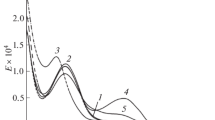Abstract
We discuss the possibility of optimizing the brightness of luminescence for phenylcarboxylates, naphthylcarboxylates, and indolylcarboxylates of europium and terbium and their adducts with 1,10-phenanthroline and 2,2′-bipyridine by modifying the ligands. We have studied the efficiency of luminescence and luminescence excitation. We consider the effect of blocking energy transfer from the ligands to the Eu3+ and Tb3+ ions by methylene (-CH2-) bridges dividing the π-electron system of the ligands into two parts and by the electronacceptor nitro group (-NO2). We have analyzed the pathways for transfer and degradation of the excitation energy at 77 K and 300 K. From the phosphorescence spectra of gadolinium salts, we have determined the energies of the lowest excited triplet states of the ligands. We consider the effect of the relative positions of the triplet levels of the ligands and the excited levels of the Eu3+ and Tb3+ ions on the luminescence efficiency. We found channels for dissipation of the excitation energy via the ππ* and nπ* states of the aromatic system of the carboxylate and the NO2 group.
Similar content being viewed by others
References
D. Ma, D. Wang, B. Li, Z. Hong et al., Synthetic Metals, 102, 1136–1137 (1999).
Y. Zheng, C. Shi, Y. Liang, Q. Lin, C. Guo, and H. Zhang, Synthetic Metals, 114, 321–323 (2000).
S. Eliseeva, O. Kotova, O Mirzov, K. Anikin, L. Lepnev, E. Perevedentseva, A. Vitukhnovsky, and N. Kuzmina, Synthetic Metals, 141, 225–230 (2004) (and references therein).
K. P. Zhuravlev and Yu. O. Yakovlev, Fiz. Tverd. Tela, 47, 1518–1521 (2005). [Physics of the Solid State, 47, 1579–1582 (2005).]
V. F. Zolin, L. N. Puntus, V. I. Tsaryuk, V. A. Kudryashova, J. Legendziewicz, P. Gawryszewska, and R. Szostak, J. Alloys Comp., 380, 279–284 (2004).
V. Tsaryuk, J. Legendziewicz, L. Puntus, V. Zolin, and J. Sokolnicki, J. Alloys Comp., 300–301, 464–470 (2000).
V. Tsaryuk, V. Zolin, J. Legendziewicz, J. Sokolnicki, and V. Kudryashova, in: Proceedings, Eleventh International Workshop on Inorganic and Organic Electroluminescence & 2002 International Conference on the Science and Technology of Emissive Displays and Lighting, Ghent University, Belgium (2002), pp. 165–168.
C. Pettinari, F. Marchetti, A. Cingolani, A. Drozdov, I. Timokhin, S. Troyanov, V. Tsaryuk, and V. Zolin, Inorg. Chim. Acta, 357, 4181–4190 (2004).
V. Tsaryuk, K. Zhuravlev, V. Zolin, P. Gawryszewska, J. Legendziewicz, V. Kudryashova, and I. Pekareva, J. Photochem. Photobiol. A: Chemistry, 177, 314–323 (2006).
J.-F. Ma, Z.-S. Jin, and J.-Z. Ni, Acta Cryst., C50, 1008–1010 (1994).
G. Novitchi, S. Shova, J.-P. Costes, O. Mamula, and M. Gdaniec, Inorg. Chim. Acta, 358, 4437–4442 (2005).
M. A. Porai-Koshits, A. S. Antsyshkina, G. G. Sadikov, E. N. Lebedeva, S. S. Korovin, R. N. Shchelokov, and V. G. Lebedev, Zh. Neorg. Khim., 40, 748–756 (1995).
V. Tsaryuk, I. Turowska-Tyrk, J. Legendziewicz, V. Zolin, R. Shostak, and L. Puntus, J. Alloys Comp., 341, 323–332 (2002).
X. Li, L. Jin, S. Lu, J. Zhang, J. Mol. Struct., 604, 65–71 (2002).
S.-P. Yang, H. Yang, X.-B. Yu, and Z.-M. Wang, J. Mol. Struct., 659, 97–102 (2003).
A. P. Suisalu, V. N. Zakharov, A. L. Kamyshnyi, and L. A. Aslanov, Zh. Eksp. Teor. Fiz., 98, 1330–1335 (1990).
R. N. Nurmukhametov, Absorption and Luminescence of Aromatic Compounds [in Russian], Khimiya, Moscow (1971).
L. M. Sverdlov, M. A. Kovner, and E. P. Krainov, Vibrational Spectra of Polyatomic Molecules [in Russian], Nauka, Moscow (1970), p. 328.
M. Latva, H. Takalo, V.-M. Mukkala, C. Matachescu, J. C. Rodriguez-Ubis, and J. Kankare, J. Lumin., 75, 149–169 (1997).
O. A. Reutov, Theoretical Principles of Organic Chemistry [in Russian], Mosk. Gos. Univ., Moscow (1964).
O. V. Sverdlova, Electronic Spectra in Organic Chemistry [in Russian], Khimiya, Leningrad (1985).
Author information
Authors and Affiliations
Corresponding author
Additional information
__________
Translated from Zhurnal Prikladnoi Spektroskopii, Vol. 74, No. 1, pp. 48–54, January–February, 2007.
Rights and permissions
About this article
Cite this article
Tsaryuk, V.I., Zhuravlev, K.P., Zolin, V.F. et al. Luminescence efficiency of aromatic carboxylates of europium and terbium when methylene bridges and nitro groups are present in the ligands. J Appl Spectrosc 74, 51–59 (2007). https://doi.org/10.1007/s10812-007-0008-9
Received:
Issue Date:
DOI: https://doi.org/10.1007/s10812-007-0008-9




